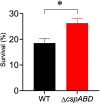Cold Shock Proteins Promote Nisin Tolerance in Listeria monocytogenes Through Modulation of Cell Envelope Modification Responses
- PMID: 35003042
- PMCID: PMC8740179
- DOI: 10.3389/fmicb.2021.811939
Cold Shock Proteins Promote Nisin Tolerance in Listeria monocytogenes Through Modulation of Cell Envelope Modification Responses
Abstract
Listeria monocytogenes continues to be a food safety challenge owing to its stress tolerance and virulence traits. Several listeriosis outbreaks have been linked to the consumption of contaminated ready-to-eat food products. Numerous interventions, including nisin application, are presently employed to mitigate against L. monocytogenes risk in food products. In response, L. monocytogenes deploys several defense mechanisms, reducing nisin efficacy, that are not yet fully understood. Cold shock proteins (Csps) are small, highly conserved nucleic acid-binding proteins involved in several gene regulatory processes to mediate various stress responses in bacteria. L. monocytogenes possesses three csp gene paralogs; cspA, cspB, and cspD. Using a panel of single, double, and triple csp gene deletion mutants, the role of Csps in L. monocytogenes nisin tolerance was examined, demonstrating their importance in nisin stress responses of this bacterium. Without csp genes, a L. monocytogenes ΔcspABD mutant displayed severely compromised growth under nisin stress. Characterizing single (ΔcspA, ΔcspB, and ΔcspD) and double (ΔcspBD, ΔcspAD, and ΔcspAB) csp gene deletion mutants revealed a hierarchy (cspD > cspB > cspA) of importance in csp gene contributions toward the L. monocytogenes nisin tolerance phenotype. Individual eliminations of either cspA or cspB improved the nisin stress tolerance phenotype, suggesting that their expression has a curbing effect on the expression of nisin resistance functions through CspD. Gene expression analysis revealed that Csp deficiency altered the expression of DltA, MprF, and penicillin-binding protein-encoding genes. Furthermore, the ΔcspABD mutation induced an overall more electronegative cell surface, enhancing sensitivity to nisin and other cationic antimicrobials as well as the quaternary ammonium compound disinfectant benzalkonium chloride. These observations demonstrate that the molecular functions of Csps regulate systems important for enabling the constitution and maintenance of an optimal composed cell envelope that protects against cell-envelope-targeting stressors, including nisin. Overall, our data show an important contribution of Csps for L. monocytogenes stress protection in food environments where antimicrobial peptides are used. Such knowledge can be harnessed in the development of better L. monocytogenes control strategies. Furthermore, the potential that Csps have in inducing cross-protection must be considered when combining hurdle techniques or using them in a series.
Keywords: Listeria monocytogenes; cell envelope; cold shock protein; nisin; tolerance.
Copyright © 2021 Muchaamba, Wambui, Stephan and Tasara.
Conflict of interest statement
The authors declare that the research was conducted in the absence of any commercial or financial relationships that could be construed as a potential conflict of interest.
Figures







Similar articles
-
Reduced host cell invasiveness and oxidative stress tolerance in double and triple csp gene family deletion mutants of Listeria monocytogenes.Foodborne Pathog Dis. 2010 Jul;7(7):775-83. doi: 10.1089/fpd.2009.0458. Foodborne Pathog Dis. 2010. PMID: 20184451
-
Cold-shock proteins affect desiccation tolerance, biofilm formation and motility in Listeria monocytogenes.Int J Food Microbiol. 2020 Sep 16;329:108662. doi: 10.1016/j.ijfoodmicro.2020.108662. Epub 2020 May 16. Int J Food Microbiol. 2020. PMID: 32505890
-
Cold-Shock Domain Family Proteins (Csps) Are Involved in Regulation of Virulence, Cellular Aggregation, and Flagella-Based Motility in Listeria monocytogenes.Front Cell Infect Microbiol. 2017 Oct 26;7:453. doi: 10.3389/fcimb.2017.00453. eCollection 2017. Front Cell Infect Microbiol. 2017. PMID: 29124040 Free PMC article.
-
Listeria monocytogenes Cold Shock Proteins: Small Proteins with A Huge Impact.Microorganisms. 2021 May 14;9(5):1061. doi: 10.3390/microorganisms9051061. Microorganisms. 2021. PMID: 34068949 Free PMC article. Review.
-
From Stress Tolerance to Virulence: Recognizing the Roles of Csps in Pathogenicity and Food Contamination.Pathogens. 2024 Jan 11;13(1):69. doi: 10.3390/pathogens13010069. Pathogens. 2024. PMID: 38251376 Free PMC article. Review.
Cited by
-
Guarding the walls: the multifaceted roles of Bce modules in cell envelope stress sensing and antimicrobial resistance.J Bacteriol. 2024 Jul 25;206(7):e0012324. doi: 10.1128/jb.00123-24. Epub 2024 Jun 13. J Bacteriol. 2024. PMID: 38869304 Free PMC article. Review.
-
Deciphering the global roles of Cold shock proteins in Listeria monocytogenes nutrient metabolism and stress tolerance.Front Microbiol. 2022 Dec 20;13:1057754. doi: 10.3389/fmicb.2022.1057754. eCollection 2022. Front Microbiol. 2022. PMID: 36605504 Free PMC article.
-
Characterization of a novel circular bacteriocin from Bacillus velezensis 1-3, and its mode of action against Listeria monocytogenes.Heliyon. 2024 Apr 22;10(9):e29701. doi: 10.1016/j.heliyon.2024.e29701. eCollection 2024 May 15. Heliyon. 2024. PMID: 38726204 Free PMC article.
-
Cesin, a short natural variant of nisin, displays potent antimicrobial activity against major pathogens despite lacking two C-terminal macrocycles.Microbiol Spectr. 2023 Sep 27;11(5):e0531922. doi: 10.1128/spectrum.05319-22. Online ahead of print. Microbiol Spectr. 2023. PMID: 37754751 Free PMC article.
-
Stress Adaptation Responses of a Listeria monocytogenes 1/2a Strain via Proteome Profiling.Foods. 2023 May 27;12(11):2166. doi: 10.3390/foods12112166. Foods. 2023. PMID: 37297410 Free PMC article.
References
-
- Abeysundara P. D. A., Dhowlaghar N., Nannapaneni R. (2019). Influence of cold stress on the survival of Listeria monocytogenes Bug600 and ScottA in lethal alkali, acid and oxidative stress. Lebensm. Wiss. Technol. 100 40–47.
LinkOut - more resources
Full Text Sources

